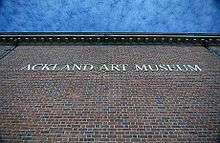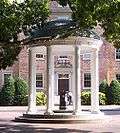Ackland Art Museum
 | |
 Shown within North Carolina | |
| Established | September 20, 1958[1] |
|---|---|
| Location | Chapel Hill, North Carolina |
| Coordinates | 35°54′44″N 79°03′16″W / 35.91236°N 79.05443°W |
| Type | Art museum |
| Director | Katie Ziglar [2] |
| Curator |
Peter Nisbet (Chief Curator) Timothy Riggs (Curator Emeritus)[3] |
| Public transit access | Chapel Hill Transit |
| Website |
www |
The Ackland Art Museum is a museum and academic unit of The University of North Carolina at Chapel Hill. It was founded through the bequest of William Hayes Ackland (1855–1940) to The University of North Carolina at Chapel Hill.[4] It is located at 101 S. Columbia Street near the intersection of Franklin Street at the northern edge of campus.
With its connection to the university, the museum is deeply committed to education and to programs that enhance learning for both adults and children. It is free of charge to visitors, and offers a wide selection of events related to exhibition, community, and university topics.
History
William Hayes Ackland, a native of Tennessee and an amateur art collector, wanted to leave money in his will to establish an art museum at a Southern university. In a 1936 will, he initially narrowed his choices to Duke University, UNC-Chapel Hill, and Rollins College in Florida, in that order, with UNC receiving the donation if Duke refused it.[5][6] After a visit to Duke's campus and meetings with the then-eager administration, Ackland decided that only Duke should receive the $1.25 million bequest and removed UNC from his will, with Rollins receiving a much smaller donation.[6] Ackland, who had turned down the chance to attend Harvard College due to family pressure to stay near home, always regretted the decision; it is speculated that he might have viewed Duke as "the Harvard of the South."[7] Ackland bequeathed Duke his entire fortune on the condition that he be buried within the newly built museum.[5] After Ackland died in 1940, Duke decided the gift had "too many strings attached" and declined it, despite the fact that three Duke benefactors—all from the Duke family—also had been buried on the Duke campus.[5]
Ackland's nieces and nephews went to court to attempt to get the inheritance themselves, and Rollins College (represented by former United States Attorney General Homer Cummings) and the University of North Carolina (represented by attorney O. Max Gardner) followed in an attempt by each college to receive the funds for the art museum.[5] The relatives took the case to the United States Supreme Court, arguing that since only Duke had been mentioned in their uncle's will, only Duke could receive the gift and they should therefore receive the money due to Duke's refusal.[6] After five years, Ackland's family members lost their case in the Supreme Court, and in 1947 a Washington, DC court found that in his final days, Ackland had been more partial to Rollins than UNC; Rollins should receive the bequest.[5] The Ackland trustees had decided that UNC-Chapel Hill should receive the donation due to both the financial condition of the university and its proximity to Duke, and an appeal of the lower court decision led to UNC being ruled the recipient of Ackland's bequest (which had grown to $1.4 million) in 1949.[7][8]
Collection
The permanent collection at the Ackland holds about 17,000 works, with its most notable regional holdings in Asian art as well as works of art on paper (i.e. prints, photographs, and drawings). The collection also has important holdings of European masterworks, twentieth-century and contemporary art, African art, and North Carolina pottery.[9] Artists in the collection include Albrecht Dürer, Jean-Honoré Fragonard, Käthe Kollwitz, Pablo Picasso, and Max Weber.
- Select gallery
-

Guercino, Assumption of the Virgin
-

Jean-Louis Le Barbier, portrait of Mélanie de Forbin-Gardanne, Marquise de Villeneuve-Flayosc (1759-1841)
-
Richard Westall's Sword of Damocles (1812)
-
Eugène Delacroix, Girl Seated in a Cemetery (1824)
-

Hiram Powers, Duff Greene, marble sculpture (1834-1837)
See also
References
- ↑ "History of the Ackland". Ackland Art Museum. Archived from the original on 16 May 2008. Retrieved 2008-04-06.
- ↑ "Staff Directory". Ackland Art Museum. Retrieved 2011-08-15.
- ↑ "Staff Directory". Ackland Art Museum. Retrieved 2011-08-15.
- ↑ "Ackland Art Museum: About". Artinfo. 2008. Retrieved 2008-07-24.
- 1 2 3 4 5 "Mr. Ackland's Wills". Time magazine. 1947-06-30. Retrieved 2008-11-30.
- 1 2 3 "Fight for a Fortune". Time magazine. 1946-02-04. Retrieved 2008-11-30.
- 1 2 "History of the Ackland". Ackland Art Museum. Retrieved 2008-11-30.
- ↑ "Chapel Hill Wins Legacy; Court Holds University Heir to Ackland's $1,400,000". The New York Times. 1949-02-04. Retrieved 2008-11-30.
- ↑ "About the Collection". Ackland Art Museum. Retrieved 21 March 2015.
External links
| Wikimedia Commons has media related to Ackland Art Museum. |
